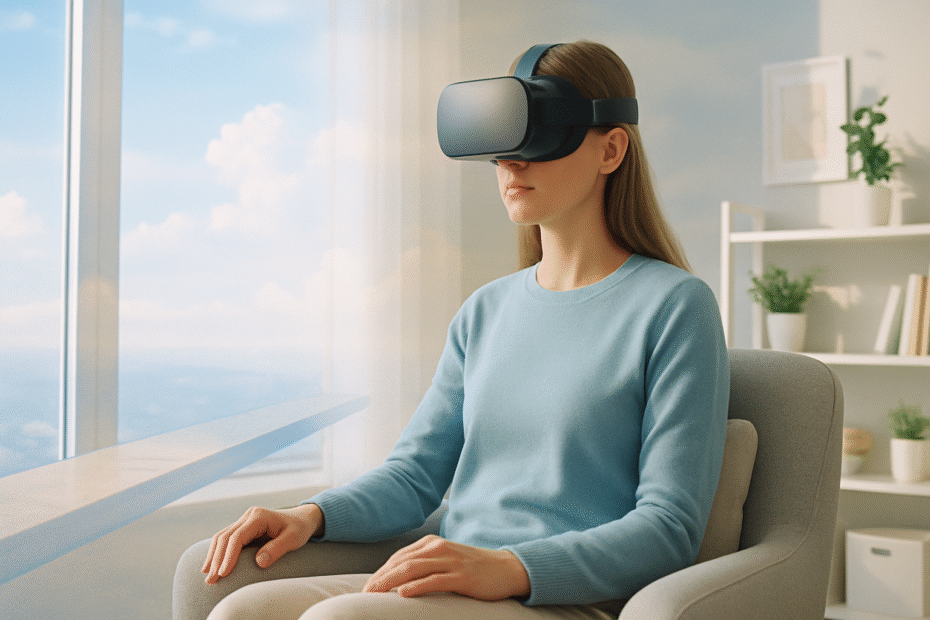Virtual Reality therapy harnesses virtual reality to deliver immersive experiences that transform mental health treatment. By using VR headsets, patients engage in controlled scenarios to tackle anxiety and phobias, guided by professionals. As virtual reality for mental health becomes more affordable, VR therapy is redefining anxiety treatment and phobia management. This blog delves into its advantages, real-world uses, and why immersive therapy solutions are the future.
Table of Contents
What is Virtual Reality Therapy?
VR therapy employs virtual reality to craft interactive, lifelike settings that support psychological healing. Patients don VR headsets to experience tailored scenarios, such as navigating a virtual crowd for social anxiety or facing heights for acrophobia, all under a therapist’s supervision. This approach, known as VR exposure therapy for anxiety, offers a customizable, risk-free way to address fears, making it perfect for virtual reality phobia treatment and conditions like PTSD or generalized anxiety.
Why Virtual Reality Therapy is a Game-Changer for Mental Health
Virtual reality mental health solutions are reshaping therapy with their unique benefits:
Cost-Effective and Accessible
Once a luxury, VR headsets like the Meta Quest 3 are now budget-friendly, enabling clinics and individuals to embrace VR therapy. This shift expands access to anxiety treatment for diverse communities.
Risk-Free Exposure
VR for phobias lets patients confront fears—like flying or spiders—in a secure, virtual space. Therapists fine-tune the experience, ensuring safe, gradual progress in virtual reality phobia treatment.
Data-Driven Customization
VR therapy systems monitor metrics like pulse or gaze patterns, allowing therapists to personalize sessions. For instance, a patient with a fear of dogs can start with a single virtual puppy and advance at their own pace.
Captivating and Interactive
The engaging nature of VR mental health therapy draws patients in, especially younger ones, turning therapy into an interactive experience rather than a clinical chore.
Versatile Applications
Beyond phobias, VR therapy is being tested for depression, substance abuse, and chronic pain, highlighting its potential as a multi-purpose immersive therapy solution.
How Virtual Reality Therapy Addresses Phobias and Anxiety
VR therapy shines in practical applications, delivering targeted relief:
VR Exposure Therapy for Phobias
Individuals with fears like heights or insects use VR for phobias to face triggers step-by-step, building confidence with professional support.
Social Anxiety Solutions
Virtual settings, such as boardrooms or social gatherings, allow patients to rehearse coping techniques, strengthening skills through virtual reality anxiety treatment.
PTSD Recovery
Trauma survivors, including veterans, use VR to revisit memories in a safe environment, reducing the impact of triggers.
Stress and Anxiety Reduction
VR mindfulness therapy offers calming virtual escapes, like serene forests, to foster relaxation and manage stress.
Proven Results and Real-World Impact
Evidence highlights VR therapy’s effectiveness. A 2020 study in The Lancet Psychiatry revealed that VR exposure therapy for anxiety significantly alleviated phobia symptoms, rivaling conventional approaches. A 2021 Frontiers in Psychiatry report noted that 80% of social anxiety patients saw lasting fear reduction after six sessions of virtual reality phobia treatment.
In practice, Oxford VR’s phobia programs are integrated into UK NHS clinics, while platforms like Psious and Limbix equip therapists with virtual reality mental health solutions, demonstrating tangible benefits.
Obstacles in Adopting Virtual Reality Therapy
Virtual Reality therapy faces challenges:
- Cost Barriers: While headsets are cheaper, advanced VR software can strain small clinics’ budgets.
- Limited Access: Patients in remote or low-income areas may lack VR-equipped facilities or stable internet.
- Comfort Issues: Some users report mild dizziness, though newer hardware mitigates this.
- Learning Curve: Both therapists and patients require training to use Virtual Reality therapy effectively, which can delay implementation.
What’s Next for Virtual Reality Therapy
The horizon for Virtual Reality therapy is promising:
- AI Enhancements: AI could create responsive VR settings that adapt to patients’ emotions, boosting virtual reality anxiety treatment.
- At-Home Options: Affordable headsets enable home-based VR mental health therapy, guided remotely or via apps.
- Insurance Support: As evidence grows, insurers may cover immersive therapy solutions, increasing access.
- Shared Virtual Spaces: Collaborative VR therapy rooms could build community and connection.
FAQ: VR Therapy for Anxiety and Phobias
How well does VR therapy work for anxiety?
Research indicates VR exposure therapy for anxiety helps 70–80% of patients, matching traditional therapy’s success.
Can I use VR therapy at home?
Yes, with affordable headsets and guided apps, VR mental health therapy is increasingly available for home use.
Is VR therapy safe?
Under professional oversight, VR therapy is safe, with minor motion sickness risks reduced by modern technology.
Conclusion
VR therapy is revolutionizing mental health treatment, offering a dynamic, effective way to address anxiety treatment and phobia management. As virtual reality for mental health becomes more accessible, immersive therapy solutions empower individuals to overcome fears in secure, virtual settings. Stay ahead of the curve with VR therapy updates—subscribe to our newsletter for the latest in mental health innovation!
